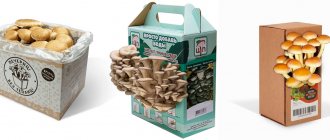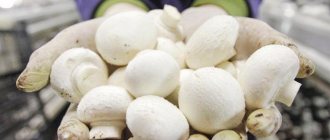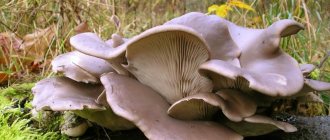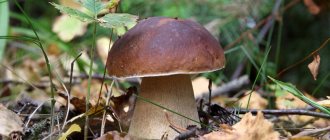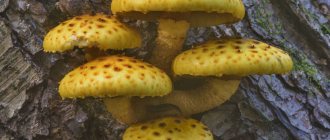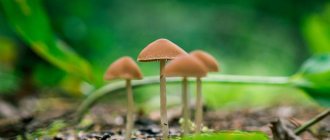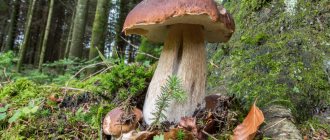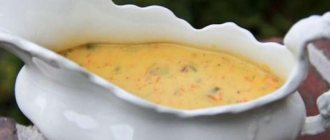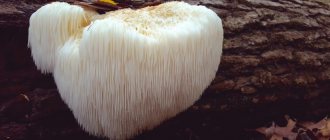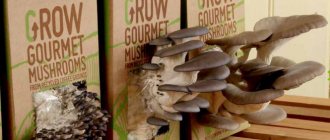Mushrooms are loved for the taste and incredible aroma they add to dishes. They can be salted, dried, pickled, fried, baked and frozen. This unique gift from nature has a lot of beneficial nutritional and medicinal properties. True, for seven praises, there is still one remark. Mushrooms are a seasonal product, and the mushroom calendar is quite capricious. One year we are literally covered with a mushroom invasion, the next the forest is greeted with a meager harvest.
If you love mushrooms as much as I do, then maybe it’s time to take the next step and grow your own edible mushrooms, for example, in the kitchen or insulated loggia? Yes, yes, you read that right! Growing edible mushrooms at home is no longer something out of the ordinary. Today, anyone can purchase a mushroom box with mycelium and harvest mushrooms within a week or a month, without leaving home.
"Silent hunt" at home
Mushroom boxes: 1 - champignons, 2 - oyster mushrooms, 3 - honey mushrooms
So, let's talk about “homemade” mushrooms? First, decide on the type of edible mushroom you would like to grow. Modern manufacturers of mycelium boxes delight you with a variety, so it will not be difficult for you to choose the right option for yourself, these could be:
- chanterelles and saffron milk caps;
- multi-colored oyster mushrooms;
- honey mushrooms and boletus;
- porcini mushrooms and boletus mushrooms;
- Champignon.
In addition, mycelium boxes are a great opportunity to find some new taste for yourself, experiment, diversify your dishes with the pungent aroma or bright color of fresh mushrooms.
Expert opinion
Trofimov Pavel Yurievich
Mushroom picker with 20 years of experience and our best mushroom expert
Ask a Question
It is better to buy a set of mushrooms not at garden centers, but to order them from specialized websites and mushroom farms. Often the mushroom boxes in the malls are not viable and the mushroom kit dies before you even buy it. You understand that you should not expect results from such a purchase.
The growing box consists of a growing medium (often sterilized manure or coffee grounds) and a grafting medium, usually something like peat, wheat bran, coconut fiber or sawdust with the fertile mycelium of your chosen mushrooms, a spray bottle for dosed watering.
Instructions for the mushroom farm
Oyster mushrooms prefer to grow on straw, compost is preferable for champignons, shiitake mushrooms love wood and sawdust, honey mushrooms love cotton waste and wheat or rice bran.
The box with the substrate has been treated, so the risk of infection by pathogenic mold or pathogenic fungi is minimized.
Since the mycelium already lives in the pre-mixed mixture, mushrooms grow much faster than those grown from spores.
How to grow honey fungus at home. Technology for self-production of mycelium
When considering how to grow honey mushrooms at home, it is worth taking a closer look at the methods for obtaining mycelium. It’s easier to buy it, but if you want, you can get it yourself.
From the pulp of a mushroom
To obtain mycelium, they use old, overripe dark brown honey mushrooms, or even wormy ones. You will only need large caps with a diameter of about 8 cm, since the mycelium forms between the membranes. The prepared raw materials are soaked in water. After a day, the whole mass is kneaded well with your hands to a paste and filtered through gauze. All mycelium will drain along with the liquid. Now it needs to be occupied immediately. Stumps or logs work best. The wood is drilled or cut into grooves with a hacksaw. The liquid is poured onto the logs. The mycelium will settle inside the grooves, which must immediately be covered with moss.
On
From a growing mycelium
This method is better called how to grow honey mushrooms yourself, but it is more suitable for summer residents or village residents. The bottom line is that reproduction occurs by mycelium from the growing mycelium. To get planting material, you will have to go to the forest or any planting where there are old rotten trees. Having found a stump with honey mushrooms growing, they try to carefully separate a piece of wood. At home, the find is cut into small cubes approximately 2 cm in size. Stumps or logs are prepared on the site, and holes of a suitable diameter are drilled. Now all that remains is to place the cubes with mycelium inside the nests and cover them with moss.
In late autumn, the stumps are covered with straw and pine branches for the winter. In spring, they try to clear as much snow as possible. A large amount of melt water can wash out the mycelium of honey mushrooms. The autumn shelter is removed from mid-June to obtain a summer harvest of honey mushrooms. To collect mushrooms in the fall, straw and branches are removed at the end of July.
Important! Artificial cultivation of honey mushrooms allows you to get only summer and winter harvests. The second option is suitable for owners of small dachas, since mushrooms can be grown outside. To obtain a summer harvest, large, damp basements with good ventilation are needed.
Beginners are especially interested in the question of how long it takes for honey mushrooms to grow from their own collected mycelium. If the technology is followed, after germination the mushrooms are cut off after two weeks. Honey mushrooms can even be simply pulled out by hand. The mycelium will not suffer from this.
Another important question is how long it takes for honey mushrooms to grow after the first wave of harvest is harvested. Mushrooms grow quickly. If moisture and temperature are maintained, a new crop will appear within 2-3 weeks.
Attention! When growing outdoors, it is impossible to say exactly how long it takes for cut honey mushrooms to grow. It all depends on the air temperature. If humidity can be maintained artificially, then cold nights will not be warmed up. To speed up growth, you can stretch a greenhouse over the mycelium.
Conditions for the mushroom box
Although any mushroom farm you order comes with instructions, it doesn't hurt to have a little extra knowledge regarding growing conditions and general care.
Place
Starting Mushroom Emergence
Select a location that is relatively warm with indirect sunlight, out of the reach of children and pets. With the compact size of the boxes, finding it won't be too difficult.
Temperature
The ideal room temperature at the time of incubation of the mycelium, when it cultivates the substrate, is usually from 20 to 23 C. Humidity during this period should be increased, in the range of 70-85%.
The temperature should remain stable throughout the subsequent growing period, without large fluctuations. Otherwise, steam condensation on the fruiting bodies will lead to a bacterial infection.
Keep in mind that mushrooms will grow very slowly or may not appear at all in places where the temperature is constantly below 16 C, and conversely, as soon as the mushrooms begin to actively grow, move them to cooler conditions, such as an insulated balcony.
Different strains of mushrooms require different temperatures to bear fruit. Some mushrooms grow up to 12 C, while others require higher temperatures.
Humidity
Spray bottle to create humidity Mushrooms that grow in the forest love damp places.
They do not lose their preferences even at home. Humidity during cultivation should be increased, at least 70%.
Daily spraying and water containers located near the mycelium will come in handy.
Lighting
Most mushrooms do not need a lot of light and therefore it is advisable to grow them in a dark place where there is a limited light source, for example, for growing in a basement, 8 hours of illumination from one light bulb will be enough.
Ventilation
Growing mushrooms need air circulation, but without drafts and wind, so for amateur cultivation, regular room ventilation a couple of times a day is enough.
How can the used substrate be used?
Due to the fact that the substrate in the mushroom chambers has to be changed frequently, many people have questions about its disposal. Therefore, a few words need to be said about this as well.
Spent substrate from growing oyster mushrooms
So, as mentioned above, the substrate for mushrooms consists of natural components, which over the period of use have turned into excellent mulch or fertilizer. Therefore, the first way to put the substrate into action is to sprinkle it on the soil in the beds. This raw material is also good for filling strawberry rows. The substrate will retain moisture under the bushes, and the berries will not lie on wet soil and rot, that is, they will be dry when harvested.
The substrate is also perfect for mulching the soil for potatoes, due to which the growth and fruiting of the vegetable will be increased, since more oxygen will flow to its roots.
You should not worry that mushrooms will populate the entire garden, since without specially created conditions for them and if the mycelium is destroyed, they will not grow.
Oyster mushrooms growing from a block with spent substrate
Another area of application is laying blocks in a shady, damp place on the site. In the open air, oyster mushrooms will begin to “hatch” from the blocks, more similar to those that grow in forest conditions. Their hats will take on rich chocolate shades. Of course, there will not be too many of them, but quite enough for the family to prepare various dishes with mushrooms all summer.
You can offer the blocks to friends or neighbors who love mushrooms and would not mind having a small mycelium on their property.
Important! If there is still excess left, you should not throw it in the trash: it would be better to pour the substrate in the forest or in the field closest to your house, which will certainly benefit the environment.
From the information presented above, you can choose the one that is necessary for different cases, that is, to obtain a small amount of mushrooms in an apartment or cottage, and also if you decide to engage in mass cultivation of this useful and beloved product by many.
Growing oyster mushrooms
Mushroom Box Harvest One of the easiest, fastest growing and most inexpensive options is to grow oyster mushrooms.
These are great as a trial for new mushroom lovers and as a unique gift. All you need to do is tear off the front of the box, cut or cut the film covering the mushroom seed substrate and let the base soak in water.
After this, you simply put the box in a suitable place: shady and warm, try to maintain the temperature within 22 C.
Remember to spray the window 2-3 times a day to maintain a moderately moist environment.
Expert opinion
Trofimov Pavel Yurievich
Mushroom picker with 20 years of experience and our best mushroom expert
Ask a Question
Additionally, create a microclimate. To do this, soak a canvas napkin in water, wring it out, place a container of water in front of the “window” and cover the box with the mycelium so that one end of the fabric is dipped into the water.
As soon as the first mushrooms appear, for their further forcing, move the box to a cooler place, with a temperature of 12-14 C. This is all that is needed for the growth of future mushrooms.
After you harvest your first crop, the base should be removed from the box, soaked in water for several hours (12 to 18), then removed, drained, and placed back in the box. Create a microclimate and do not stop spraying daily. Soon the mycelium will delight you with another portion of mushrooms. And so on until its service life expires.
You can order a mushroom farm with oyster mushrooms on the official website of the manufacturer.
Oyster mushrooms need intense lighting, at least 12 hours a day. It is better to illuminate mushrooms with fluorescent lamps; if you grow them in a cellar or basement, one lamp will be enough. Similar growing conditions are suitable for bright red chanterelle beauties.
Lack of light will affect the fruiting bodies, namely, too small caps and long legs.
Description, characteristics and benefits of chanterelles
The peculiarity of this type is that the cap and leg are a single whole. Externally, it can be compared to an umbrella turned outward.
The color of this mushroom is light yellow, but among them there are specimens with a bright orange color. Thanks to their color, they got their name. The chanterelle's hat is smooth with wavy edges and reaches a diameter of 12 cm.
The stem of the mushroom is narrow at the bottom and widens at the base of the cap. Outwardly, it can also be compared to a forest flower, which is what many mushroom pickers do. Chanterelle has a light sour aroma.
The pulp of this mushroom contains vitamins B, D, PP. Among microelements, copper and zinc salts can be noted. Chanterelles are rich in beta-keratin, which gives them their bright yellow color. Since the composition of this mushroom is rich in valuable substances, amino acids and vitamins, the fruiting bodies have a large number of medicinal properties:
- reduce blood cholesterol levels;
- increase immunity;
- suppress the growth of cancer cells;
- remove toxins;
- strengthen the walls of blood vessels;
- cleanse the liver and normalize its function;
- help fight excess weight;
- improve vision;
- help normalize heart rate;
- help in the fight against infections during bronchitis, sore throat, furunculosis.
Contraindications for use are:
- children under 7 years of age;
- individual intolerance;
- period of pregnancy and breastfeeding.
Box with honey mushrooms
The process for preparing a box of mushrooms is the same as for oyster mushrooms. After you prepare the box and moisten the base, provide the future mycelium with the proper conditions, namely:
- average temperature 10-15 C;
- daily ventilation of the room;
- additional illumination with fluorescent lamps with diffuse lighting, 5-6 hours;
- humidifying the air using: water in containers, wet rags or a spray.
At first, keep the box in a warm room, with a temperature of 23-26 C, as soon as the mycelium germinates, the temperature should be immediately reduced to 12 C. The mushrooms can be placed on a window sill on the north side of the house or an insulated loggia.
In summer, mushrooms must be kept in a cool room.
The harvest can be harvested 14 days after planting. Remove the mushrooms from the substrate carefully, cutting them with one hand and holding them around the root with the other. Then clean the growing area by removing the remaining stems of dead mushrooms. Soak the base in water for several hours, place it in a box and wait for the next harvest. With proper care, it won't keep you waiting long. Similar conditions are suitable for growing butternut squash.
Expert opinion
Trofimov Pavel Yurievich
Mushroom picker with 20 years of experience and our best mushroom expert
Ask a Question
Do not forget that honey mushrooms, no matter how tasty they are, are fungal parasites that can grow on living and dead wood. Therefore, when growing them in a wooden house, be prepared for the fact that they will “run away” onto the walls.
How to grow honey mushrooms at home from mycelium. Growing honey mushrooms at home
Honey mushrooms are considered one of the most famous species that are adapted for growing at home.
They attract not only with their excellent taste, but also with their incredibly fast growth, which allows them to be grown in small areas. There are several types of mushrooms that are most suitable for growing at home:
- winter view;
- summer look.
The first of them not only tastes very good, but also contains substances that increase the healing properties of the plant and the human body’s resistance to cancer. It is a well-known fact that only the cap of forest honey mushrooms is used as food, while domestic mushrooms use both the stem and the cap.
Special conditions for growing honey mushrooms at home:
The winter species can be grown both in a cold room and in a warm room. The most important thing is to provide the right growing conditions, where the mushroom will grow and reproduce properly.
Rules:
— constant temperature ranges from approximately 10 to 15 degrees Celsius;
— the room humidity should be quite high (80%);
- correct lighting;
— heating in the cold season, and cooling in the summer;
It is also necessary to ensure proper protection of mushrooms from pests and pathogenic bacteria.
Growing method:
- in a greenhouse;
- in banks;
- on the stumps.
The most economical way is to grow honey mushrooms at home on stumps. The essence of the method is to introduce mushroom mycelium into special holes in wood measuring 2 centimeters, and then cover them with a small layer of moss.
It is important to know that if mushrooms are introduced into growing wood, then the ground around them should sometimes be watered with soil, and if it is in felled wood, then it should be kept in water for two days and only after that the mushrooms should be “populated.”
In order to increase the rate of growth and development of the fungus, the wood along with it should be sent to the basement with a temperature of about 20 degrees Celsius, and then covered with straw. In order to constantly maintain the required humidity in the room, you should wash the floor and walls every day. As soon as you see the presence of mycelium, you need to take the logs out to the site and dig them in. Within a year you will receive the first harvest of mushrooms, which will continue to produce fruit until the log itself falls apart.
If you don’t have your own plot, there is a way to grow in jars. The main task of this method is to properly prepare the nutrient substrate. For this you need:
- wood sawdust;
- small chips;
- water;
- starch;
- oatmeal and corn flour.
We boil the first three ingredients and turn them into a kind of “mush”, and then add the rest later.
Growing Shiitake
Some farms use a box that is pre-filled with growing medium inoculated with spores.
Others come complete with hand-cut logs, pre-drilled holes that are filled with fungal spores or mycelium, and then coated with cheese wax to protect against insects and other natural predators.
Whichever option you choose, it is easy to clean and maintain. All you need to do is keep the mycelium base moist and at a relatively constant temperature throughout the growing cycle.
Germination of the mycelium takes about a month, at a temperature of 25 C and 80% humidity. Then, the sprouted mycelium is transferred to a room with diffused lighting and good ventilation. Recommended microclimate parameters are temperature 15-20 C, humidity not less than 85%.
The harvest is formed in stages; each batch of mushrooms must be carefully cut off at the very base of the stem.
If you are not a stranger to experiments, try growing more exotic mushrooms than classic champignons and oyster mushrooms.
Lion's mane
Also known as satyr's beard and bearded tooth, this mushroom is an excellent addition to seafood and is rich in protein and has medicinal properties.
It has a bizarre shape and looks like an icicle. Feels great on wood chips, maintaining the humidity of the growing environment; the first results will appear in just two weeks.
With good care, the harvest can be harvested in 30-45 days.
Reasons why mushrooms may not grow
While many factors can affect successful mushroom growing, there are some common mistakes that can be easily avoided. If you are just learning to grow mushrooms, then this knowledge will be useful to you.
Lack of moisture
Mycelium needs a moist environment to thrive and produce mushrooms. Mushrooms themselves are essentially water, so if you allow the mycelium to dry out or the air humidity becomes too low, the mushrooms will either slow down or not grow at all. For effective mushroom growth, control the humidity level in the area where your mushroom boxes are located.
Excess moisture
Too much moisture, on the other hand, can lead to a damp box, mold and standing water, which will negatively impact the health of the mycelium. If the mixture looks like it is starting to dry out, spray it lightly.
Expert opinion
Trofimov Pavel Yurievich
Mushroom picker with 20 years of experience and our best mushroom expert
Ask a Question
An air humidifier will help you create comfortable conditions in the room where mushrooms grow. By creating a fog effect, you can control the development of mushrooms and their yield, prevent waterlogging, the development of mold and disease.
Air exchange
Although mushrooms do not need a lot of fresh air, they do need a well-ventilated area without strong air currents or air movement (not near an open window).
Lack of air exchange will cause the level of carbon dioxide to begin to accumulate and affect the development of fruiting mushroom bodies.
- the shape of the mushrooms is distorted, namely, the legs lengthen, and the diameter of the caps, on the contrary, decreases, or there are no caps at all;
- the caps may acquire a burdock-like shape with raised edges;
- the height of the fruiting body increases 5-6 times;
- the fruiting body becomes fragile;
- productivity decreases.
To ensure access of oxygen to the mycelium, ventilate the room in which your mushroom boxes are located several times a day, 3-4 times.
Low level of production
One of the fundamental reasons for the failure of mushroom boxes is non-viable mycelium.
To avoid this problem, buy mushroom farms only from trusted manufacturers, focusing on product reviews on specialized forums.
When receiving goods by mail or through a courier, pay attention to the expiration dates of the mycelium.
Variety of mushroom farms
How to grow honey mushrooms at home step by step. 6 ways to grow honey mushrooms at home
Honey mushrooms are one of the most popular mushrooms, since they can not only be collected in the forest, but also grown independently in your dacha or balcony. Summer and winter varieties of honey fungus are best suited for breeding at home. They are not fancy and do not require much effort even for a beginner.
Conditions for the growth of honey mushrooms are easy to arrange both at home and in a summer cottage or garden. The best time for planting planting material outdoors is in April-May or August, and in the house (warm balcony, basement) throughout the year.
Honey mushrooms are considered the most delicious and aromatic mushrooms
The air temperature at different stages of growth should be from +10 to +25°C.
With a uniform and high level of humidity, the mycelium develops quickly, which has a beneficial effect on the growth of mushrooms. The building should be well ventilated, this could be a window or built-in ventilation.
The light needed for mushroom growth is not bright; it can be grown in almost semi-darkness. Only then will the caps of the mushrooms be pale, but this will not affect their taste.
At the dacha, it is better to choose a shady place for planting honey mushrooms so that the wood on which the mycelium is located does not dry out.
You can grow honey mushrooms using the following methods:
- in the basement on bags;
- on logs;
- in greenhouses;
- in banks;
- on the stump.
In the basement on bags
The premises must be disinfected before planting. The basement should have good ventilation all year round. In winter it needs to be heated.
Growing honey mushrooms in bags
For soil for sowing mycelium use:
- chopped straw;
- tree foliage;
- sawdust;
- seed husks;
- ready-made substrate blocks.
All plant components are steamed with hot water for 12 hours to disinfect them from pests and mold. After cooling, add honey mushroom mycelium (according to the manufacturer’s instructions) and mix thoroughly. Then the mixture is laid out in dense plastic bags from 5 to 50 kg. The tied bags are placed on racks or hung in the basement.
After three days, holes about 5-6 cm long are cut in the bags. After 14-20 days, the mushrooms will germinate and become noticeable.
For normal growth of honey mushrooms at this stage, good lighting, high humidity and a temperature of +14 to +16 ° C are necessary.
They can be used to grow mushrooms both outdoors and indoors at temperatures from +10 to +25°C. A log from a larch tree should not be rotten, but moist and with bark. Length 300-500 mm, diameter 200-500 mm. If it is dry, then it is soaked in water for two or three days. Then they take it out and let the water drain.
Preparing logs for growing honey mushrooms
There are three ways to grow honey mushrooms on logs:
- Holes are made in the logs 1 cm in size, 4 cm long and at a distance of 10-12 cm from each other. Mycelia on wood sticks are inserted into them. Hands must be absolutely clean. After this, the logs are wrapped in plastic film, making several holes in it so that air can pass inside. They are then transferred to a damp, dark room. At 20°C, the log will be overgrown with honey mushroom mycelium within 3-4 months.
- On a personal plot, dig a hole 15 cm deep on the shady side and water it. Then wood with a mushroom stick is placed in it in a horizontal position. The soil around the planting is sprinkled with wood ash to repel snails. Watering is carried out regularly so that the soil does not dry out. Cover with leaves for the winter.
Growing honey mushrooms on logs
- The prepared log can also be planted in a tub or barrel with earth and placed on the balcony. For normal growth, you need to constantly maintain a temperature of +10 to +25°C and high humidity.
A hygrometer is used to determine the percentage of humidity.
Greenhouses and greenhouses are well suited in terms of temperature and humidity level for growing mushrooms. Logs, stumps, logs are moistened and placed in a greenhouse.
After that, holes are made in the wood and honey mushroom mycelium is planted, or they can be watered with a solution containing fungal spores.
The planting is regularly watered to maintain moisture, and the air temperature is also monitored. You can also grow mushrooms in greenhouses in jars, bags or on substrate blocks.
In banks
This method of growing honey mushrooms allows you to do without garden plots. The jar can be placed on the balcony or on the windowsill.
Growing honey mushrooms in jars
For the growth of mycelium, a substrate is made - a mixture of sawdust (preferably larch) and bran in a 3:1 ratio. For one day it is filled with water, then squeezed out and not compacted much.
To prevent the mycelium from becoming infected with mold, the jar with the substrate is sterilized in hot water for an hour.
After the mixture has cooled, use a clean stick to make a depression in it to the bottom of the jar and place the mushroom mycelium. The container is closed with a lid with holes and covered with wet cotton to maintain humidity. The jar is placed in a dark and warm place. As the cotton dries, moisten it.
The mycelium will germinate in a month, and after 15-20 days the first mushrooms will appear. As soon as the mushrooms sprout, the container is placed on the windowsill on the north side, or darkened from the sun.
When they reach the lid, it is removed and the neck of the jar is wrapped with a wide strip of cardboard. This will help the honey mushrooms hold on while they grow. To maintain moisture, mushrooms are sprayed with water.
As the crop grows, it is cut off and the remaining stems are pulled out. In 14-20 days, new honey mushrooms will grow.
Growing on a stump
Planting of mycelium on a stump is done in the warm, but not hot, season. In the forest, mycelium is found on old stumps or tree trunks and part of it is separated along with a piece of wood. For planting, holes are cut in the hemp and pieces of mycelium 1-2 cm in size are placed. Then they are covered with damp moss or sawdust. The soil around it is watered, not allowing it to dry out.
Spore breeding method
Caps of overripe mushrooms with a dark brown color underneath are selected. Place them in a container and fill them with clean water for 24 hours. Then, without taking them out of the water, rub them with your hands. The resulting mass is filtered.
A solution containing spores is poured over stumps or logs with notches made in them. Thanks to them, the wood is better saturated. After which they are covered with damp moss or sawdust. Spores take a long time to germinate; mushrooms will grow only after 1-2 years.
After the mycelium has grown on wood or stumps, it can be propagated. To do this, part of it is carefully separated and transplanted to a new place.
Honey fungus mycelium
You should only buy mycelium in specialized stores, since they store the goods under the right conditions. If, while growing winter mushrooms in containers, the temperature rises high, then they should be put in the refrigerator for several days. The temperature should be no more than +8°C, but not less than +4°C.
Is it worth growing at home?
Do you want to grow mushrooms at home?
I really don't want to
If you really love them, then why not.
- boxes of homemade mushrooms can be a great hobby for everyone in the family, and growing small quantities in a controlled environment will not be burdensome;
- you will receive a nutritious product with high energy and dietary value for relatively little money;
- the mycelium box is easy to maintain, and you fully control the growing process from “A” to “Z”, without much difficulty;
- mushrooms grown by yourself are of high quality;
- You can grow mushrooms all year round;
- mushroom boxes are ready for use immediately after purchase without prior preparation;
- guaranteed harvest in 2-3 weeks.
Best Mushroom Farm Kits
The best producers 1 - Homemade mycelium "Oyster mushrooms".
2- Mushroom kits from Tatgrib for growing champignons and oyster mushrooms. 3 — “Mushroom farm” kits using Canadian technology. If you are new to this business, then when buying your first mycelium box, try to rely on reviews. For example, more than half of the reviews report good results, and satisfied customers share photos of their mushroom harvests, then I think this manufacturer's product is good and definitely worth trying.
